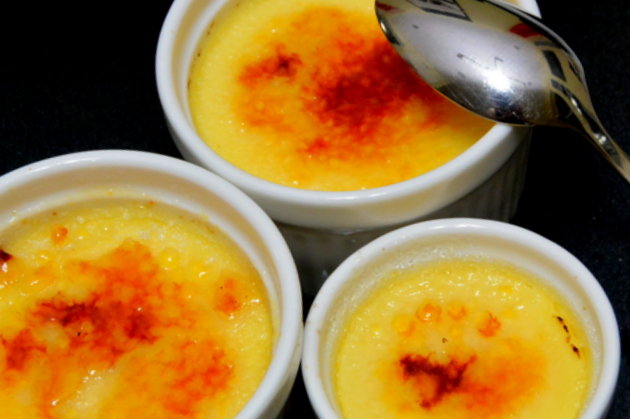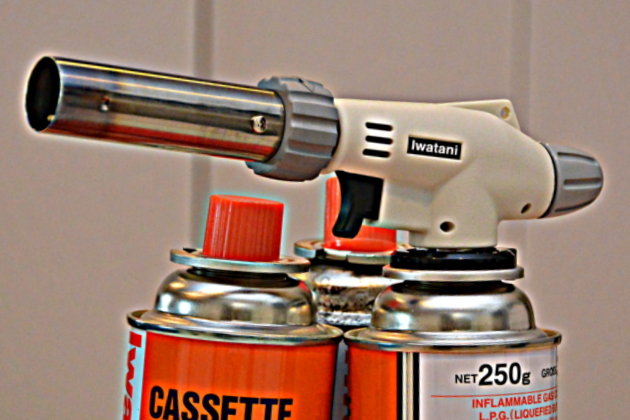
Luxurious Burnt Dessert
By The Feiloh - Friday, Jul 26, 2013
The dessert crème brulee (“cram broo-lay”) offered in fancy restaurants used to hold great attraction for me. Usually served in a small thick-walled bowl or ramekin, this custard of cream-and-eggs has a lovely, browned (or “burnt”) sugar crust on top.
The definitive test for this crust is that it must break with a satisfying crack when you tap it sharply with your spoon. The custard below thus exposed must be smooth and creamy. The traditional flavour has always been plain ol’ vanilla, but some chefs have taken to introducing newer flavours like orange, lemon, coffee and – closer to home – that of the fragrant pandan leaf.
Whatever floats your boat, you can pay northwards of S$10 for this luxurious treat so it may be worth your while to make it at home. And you get to impress your friends and family at the same time while saving money.
The custard is simple and I stick to a ratio of six large eggs to one litre of pure cream and you can get this cream from bakery supply houses. Do not use those creams that come with additives like gums or gelatine meant to increase volume when whipped, which will only leave you disappointed.
You may not want to use up all of one litre of cream so start with three eggs to half a litre of cream for your first attempt. You can use the remainder of the cream for other dishes like creamy soups or a savoury custard like quiche.
You will need some ramekins and these are specially made to withstand oven baking while being attractive for serving directly at the table. These are usually sized to contain one cup (250ml) or less. You can find them in specialty kitchen stores or in department stores. In a pinch, you may also use any small, thick-walled ceramic deep dishes, bowls or mugs like old-styled kopitiam coffee cups that can take the heat of the torch.
The ramekins may come bundled in a set with a butane gas torch from department stores. That’s where I got my first torch but the plastic nose of that little device melted with my over-enthusiastic experimentation. I now use an industrial-grade torch from hardware or specialty kitchen supply stores (S$20-25) running off butane in those gas canisters (S$3-4) for table top hotpot stoves.
These are inexpensive investments because you can use this tool for other dishes like baked Alaska dessert or for searing tuna steaks. For folks who have ovens with a broiler (top heating) function or “salamander”, you can caramelise your crust without having to use the torch.
The traditional method of cooking the custard is to use a “bain marie” or hot water bath where you put your ramekins in a deep oven tray, pour hot water to fill it before placing the tray in the oven to provide even heat to cook your custard.
After having been both scaled and burned with this medieval European torture method, I now use the traditional Asian method of steaming the custard. It’s faster , cheaper and a lot safer.
Once the custard has been cooked, cool the ramekins before placing it into the refrigerator for at least an hour. Thereafter, you can just add one teaspoon of fine sugar to the top of the custard and heat with the torch to melt and caramelise it.
Have fun, blaze away!
Steamed Crème Brulee

Ingredients
500ml pure cream
3 large (60g or more each) eggs
1-1/2 tablespoons of fine (caster) sugar, plus more for the crust later
1 teaspoon vanillas extract (not essence)
Methods:
1) In a large bowl, beat well cream, eggs, sugar and vanilla extract. You may use a whisk or electric beater/blender stick.
2) Strain through a sieve to remove any lumps and to reduce bubbles.
3) Divide mixture into ramekins, mugs or bowls (as long as they are of the same volume). Fill to 80% of the ramekin’s height.
4) For ramekins of half a cup (125ml), steam on high heat for 10 minutes in a wok, electric rice cooker or steam oven. Stick a toothpick into the centre of the custard and withdraw. When cooked, nothing should stick to the toothpick. Adjust your cooking time accordingly but do not over-steam the custard.
5) Allow the ramekins to cool for 30-60 minutes before putting them uncovered into the refrigerator for at least an hour.
6) Before serving, add one teaspoon of fine caster sugar to each ramekin. Roll and rotate the ramekin until the sugar is evenly distributed on the surface.
7) Place your ramekin on a flat baking tray to protect your table top and remove anything flammable from the area.
8) Fire up your butane torch and adjust the flame according to the manufacturer’s instructions.

9) Blow the flame over the sugar, rotating the tray or moving the torch to evenly melt the sugar. When one area starts to brown, move the flame to another area. Stop when majority of the surface has turned brown and return to the refrigerator to cool for a few minutes, taking care that the top of the ramekin can be hot.
10) If you mess up and turned the sugar to carbon, do not panic. Just cool that ramekin in the refrigerator for a few minutes, pry off the crust with a butter knife, sugar up that portion and try again.
11) If you have leftover custard mixture and want to continue the next day, allow the cold raw mixture from the refrigerator to warm up at room temperature for 30 minutes before steaming or you will throw off your cooking time. It is best to use up all the custard at one go.
12) Some planning and timing are required: do not leave the caramelized custards in the refrigerator for too long before serving or the crust will melt with the water in the custard. Take heart and experiment a bit, forgiving yourself for making mistakes. After all, you can eat your mistakes and your guests will only get to see and appreciate the nice ones. Soon you will be a master of the flame.


